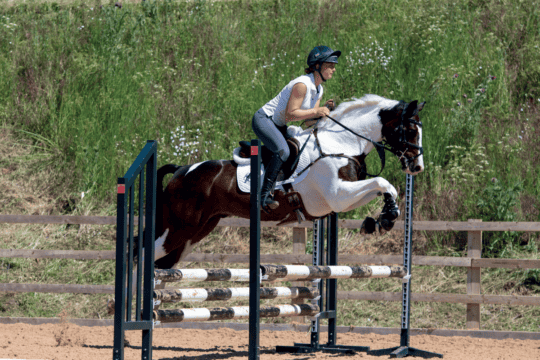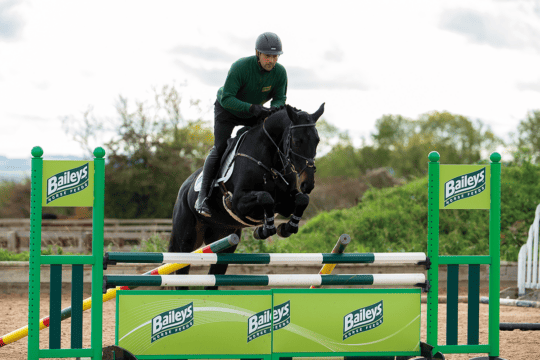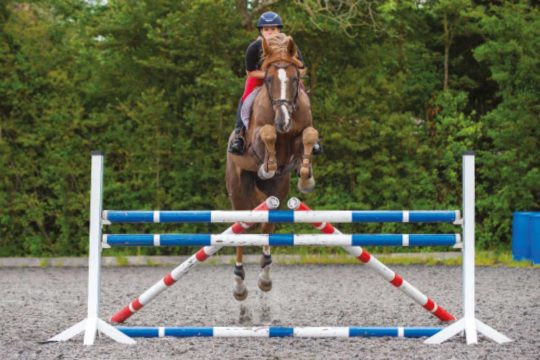-
Riding Schooling and Training
-
Health and Veterinary
-
Management
-
Mind Matters
-
Buying and Selling
-
Insurance Advice
FAQs
Don’t let a lack of cross-country fences put you off your goals – you can recreate some of the staples of the cross-country course in your school. H&R explains how
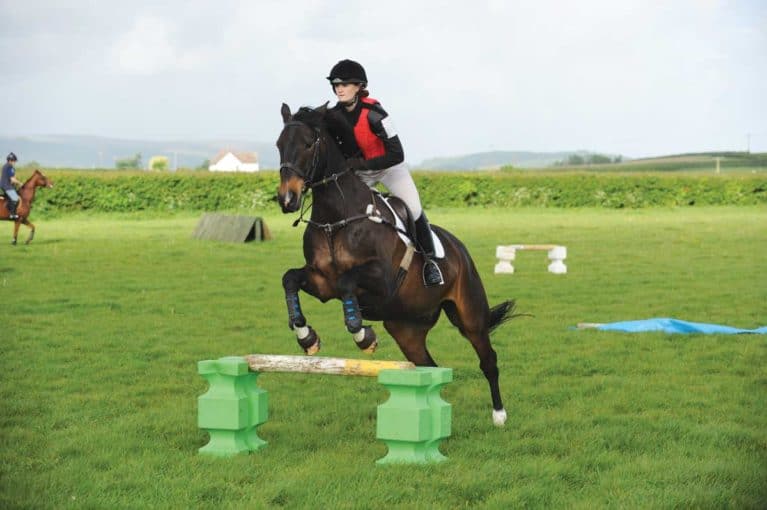
Have you ever walked a cross-country course and picked out the bogey fences – those that look far more intimidating than the rest of the course, where you’re sure you’ll run into problems? These rider frightener fences are designed to test your bravery and are often straightforward to ride, but they do require confidence, which you can build up with plenty of practice.
However, unless you’re lucky enough to have a cross-country course at your yard, it’s unlikely you get the chance to school over these obstacles regularly.
Practising paces
One skill that you’re unlikely to practise in the school, but which is essential to good cross-country riding, is the ability to jump out of different canters. There are generally three canters that you’ll want in your arsenal on the course, so if you have a field or an open space that you can set up a couple of fences in, it’s worth doing so to get comfortable with them…
- the coffin canter is short, active and bouncy, similar to a showjumping canter, and allows you to manoeuvre combinations and technical questions, or jumps followed by ditches or water
- the cross-country canter is more forward than the coffin canter, but still contained, and appropriate for skinny fences and jumps on a turn
- the fast canter shouldn’t be out of control, nor should it be the top speed that your horse can go. Instead, it’s balanced and attacking, and is suitable for straightforward fences such as tables, roll tops and brush fences. Learning to jump out of a faster canter requires practice in order to get comfortable with it.
Ditches
Ditches are one of the most common concerns and they’re also one of the easiest to practise at home. To build an artificial ditch, fold a piece of tarpaulin to create a rectangle with a jumping width of approximately 60cm. Secure it by placing heavy wooden poles on the take-off and landing sides – this will stop the tarpaulin from blowing away and simulate the revetting on a proper ditch, creating an optical illusion for your horse and allowing you to tackle it as though it were the real thing.
How to ride it: Allow your horse to familiarise himself with the ditch by letting him have a look at it from all angles. Walk him around and alongside it until he’s used to it, then circle, approach in trot and aim for the middle of the artificial ditch. Your horse may hesitate or make an awkward effort over it the first time he jumps it, so keep your leg on and forward, and your upper body upright to avoid catching him in the mouth. Praise him on landing, then reapproach immediately in a positive trot. Once you’ve both got the hang of the small ditch, you can approach in an active, bouncy canter, then begin to widen the tarpaulin.
Up the ante
Create a simulated trakehner by setting up a small upright over the tarpaulin ditch. Ride positively, as though the ditch isn’t there, and keep your eyes up – this will encourage your horse to keep his focus on the fence and beyond, rather than inspecting the ditch for monsters.
TOP TIP – Always start small when introducing new concepts to allow you and your horse to focus on tackling them correctly without worrying about the height of the jump.
Skinnies
Skinny fences are a staple of cross-country courses and can often be found in combinations, testing your ability to ride a line assertively. If you don’t have short poles or planks at your yard, you can create a simulated skinny by setting up a regular fence and using an extra jump wing to make the jumpable space narrower. Or you could try using fillers on their own as small skinnies. Alternatively, make a line of jump blocks and pop over them, removing one at a time to narrow the fence. Feeling up for a bit of a challenge? Continue to remove the blocks until you can comfortably jump one on its own.
Make it count
Once you’ve mastered skinny singles, try incorporating them into combinations. A spread fence to a skinny upright on a dog-leg turn is a great test of your ability to pick your line and commit to it.
Corners
Corners needn’t be frightening – the trick to getting them right is knowing where to jump them. You can build a corner at home with a barrel or a block – simply place two wings on one side with poles in the cups, as though you’re building half a spread fence, then place the other end of the poles on top of the block. Start with the wings about 60cm apart, with the poles tapering together until they touch on top of the block. Start small and as you become more comfortable with the jump, you can widen the wings until they’re up to 1m apart and raise the height of
the fence.
How to ride it: Imagine there’s a line bisecting the triangle shape created by the poles. Ride into the fence so this imaginary line is perpendicular to your approach and aim for the centre of the fence. Ridden properly, a corner will feel like a straightforward spread to jump.
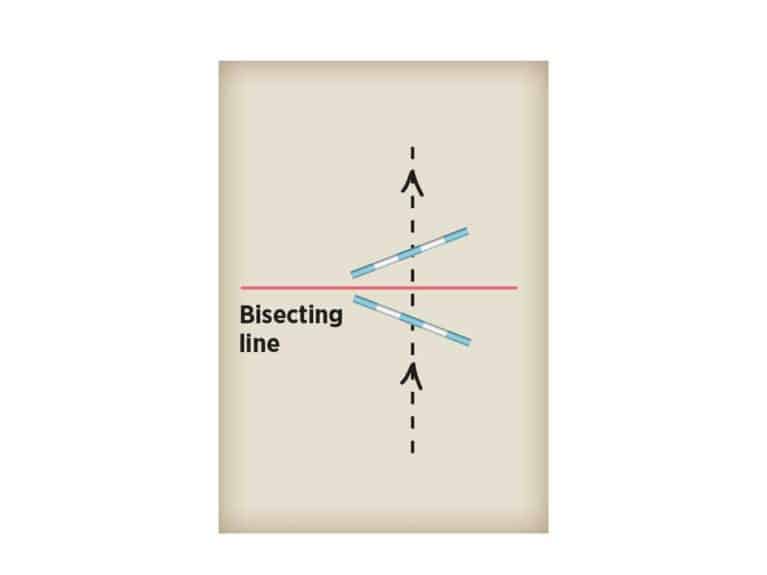
TOP TIP – Check with your yard owner before working in a waterlogged school – depending on the footing used and the condition of the membrane, it may cause damage to the school.
Drilling the unbuildables
Two obstacles that are likely to be on every cross-country course you ride, but which are tricky to recreate in the school, are water jumps and banks. But with a little bit of creativity you can still hone the essential skills needed to tackle these obstacles.
The key to mastering banks is to get comfortable with changing your position as you go up or down. Your position should always be balanced over the ground in such a way that if your horse were to disappear from underneath you, you would land
on your feet. This means that when jumping up a bank, your leg will be further behind the girth than when on the flat in order to keep it perpendicular to the ground. When jumping down, your leg will be further forward and your upper body further back.
To practise these skills, try to find hacking routes or paths at your yard that have varying terrain. Make it part of your regular riding routine to ride your horse up and down these natural banks and sharp inclines in walk, allowing your body to adjust. Then, when you tackle a proper bank at a faster pace, you’ll already find it more natural to adjust your position.
Water jumps are similarly tricky to build at home, but summer showers can offer you the opportunity to practise getting your horse’s feet wet. Make walking through any puddles you come across a regular part of your horse’s routine and he’ll soon learn that he can trust you not to ask him to travel into water that’s out of his depth. Likewise, if your school tends to get waterlogged after heavy rainfall, use it to your advantage and allow your horse to work through it.




